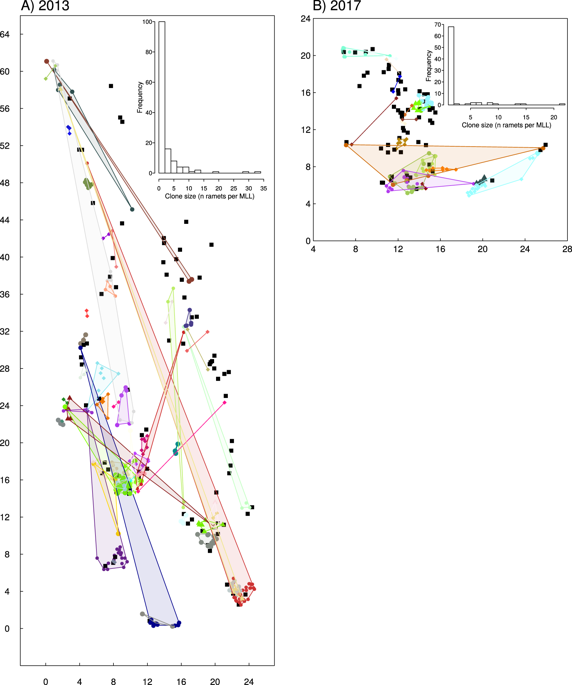Our official English website, www.x-mol.net, welcomes your
feedback! (Note: you will need to create a separate account there.)
Increased spatial-genetic structure in a population of the clonal aquatic plant Sagittaria latifolia (Alismataceae) following disturbance
Heredity ( IF 3.1 ) Pub Date : 2019-12-11 , DOI: 10.1038/s41437-019-0286-z Ryan Holt 1 , Allison Kwok 1 , Marcel E Dorken 2
Heredity ( IF 3.1 ) Pub Date : 2019-12-11 , DOI: 10.1038/s41437-019-0286-z Ryan Holt 1 , Allison Kwok 1 , Marcel E Dorken 2
Affiliation

|
The spatial genetic structure (SGS) of plant populations is determined by the outcome of key ecological processes, including pollen and seed dispersal, the intensity of local resource competition among newly recruited plants, and patterns of mortality among established plants. Changes in the magnitude of SGS over time can provide insights into the operation of these processes. We measured SGS in a population of the clonal aquatic plant, Sagittaria latifolia that had been disturbed by flooding, both before and after the flood. Over the four-year interval between measurements, we found substantial changes in the magnitude of SGS. In the first measurement (pre-flood), SGS was weak, even over short distances. By contrast, there was substantial SGS in the second measurement (post-flood), particularly over short distances. This change in SGS was accompanied by near complete turnover in the genotypic composition of the population. The genotypic richness of the population (the number of unique clones scaled by the sample size) was halved over the four-year interval. The clonal subrange—the distances between shoots within clones—also shrank considerably, with more than 5% of shoots having clone-mates at distances >10 m before the flood, but fewer than 5% of shoots having clone-mates at distances beyond 2 m afterwards. Clonal turnover and the re-establishment of SGS in clonal populations are both expected following local extirpation and recruitment. These data reveal the genetic signatures of disturbance and a subsequent flush of seedling recruitment and clonal expansion.
中文翻译:

干扰后克隆水生植物慈姑(泽泻科)种群的空间遗传结构增加
植物种群的空间遗传结构(SGS)由关键生态过程的结果决定,包括花粉和种子传播、新招募植物之间的当地资源竞争强度以及已建立植物的死亡率模式。 SGS 强度随时间的变化可以提供对这些过程操作的深入了解。我们在洪水之前和之后测量了受洪水干扰的克隆水生植物慈姑 (Sagittaria latifolia) 种群的 SGS。在四年的测量间隔内,我们发现 SGS 的幅度发生了巨大变化。在第一次测量(洪水前)中,SGS 很弱,即使是在短距离内。相比之下,第二次测量(洪水后)有大量 SGS,特别是在短距离内。 SGS 的这种变化伴随着人群基因型组成的几乎完全更新。种群的基因型丰富度(根据样本大小缩放的独特克隆数量)在四年的时间间隔内减半。克隆亚范围(克隆内枝条之间的距离)也显着缩小,洪水前超过 5% 的枝条在距离 >10 米处有克隆交配,但只有不到 5% 的枝条在距离超过 2 米处有克隆交配。米之后。局部消灭和招募后,克隆群体中的克隆周转和 SGS 的重建都是预期的。这些数据揭示了干扰的遗传特征以及随后的幼苗招募和克隆扩张的激增。
更新日期:2019-12-11
中文翻译:

干扰后克隆水生植物慈姑(泽泻科)种群的空间遗传结构增加
植物种群的空间遗传结构(SGS)由关键生态过程的结果决定,包括花粉和种子传播、新招募植物之间的当地资源竞争强度以及已建立植物的死亡率模式。 SGS 强度随时间的变化可以提供对这些过程操作的深入了解。我们在洪水之前和之后测量了受洪水干扰的克隆水生植物慈姑 (Sagittaria latifolia) 种群的 SGS。在四年的测量间隔内,我们发现 SGS 的幅度发生了巨大变化。在第一次测量(洪水前)中,SGS 很弱,即使是在短距离内。相比之下,第二次测量(洪水后)有大量 SGS,特别是在短距离内。 SGS 的这种变化伴随着人群基因型组成的几乎完全更新。种群的基因型丰富度(根据样本大小缩放的独特克隆数量)在四年的时间间隔内减半。克隆亚范围(克隆内枝条之间的距离)也显着缩小,洪水前超过 5% 的枝条在距离 >10 米处有克隆交配,但只有不到 5% 的枝条在距离超过 2 米处有克隆交配。米之后。局部消灭和招募后,克隆群体中的克隆周转和 SGS 的重建都是预期的。这些数据揭示了干扰的遗传特征以及随后的幼苗招募和克隆扩张的激增。









































 京公网安备 11010802027423号
京公网安备 11010802027423号